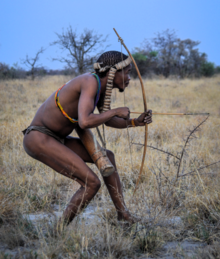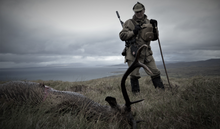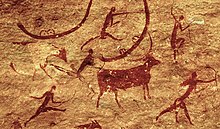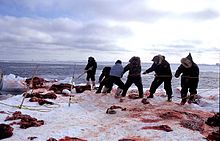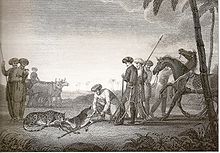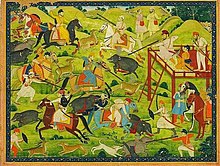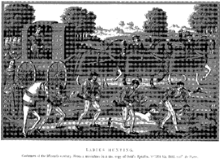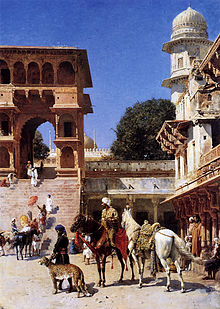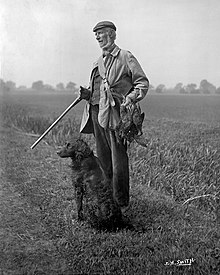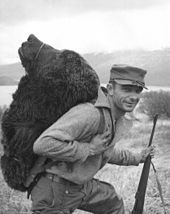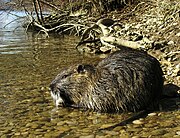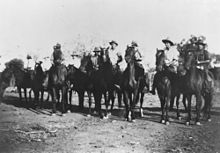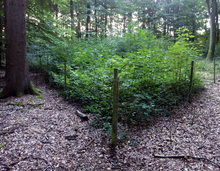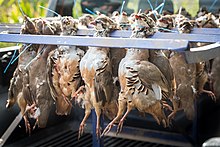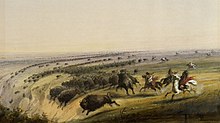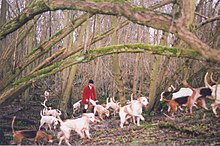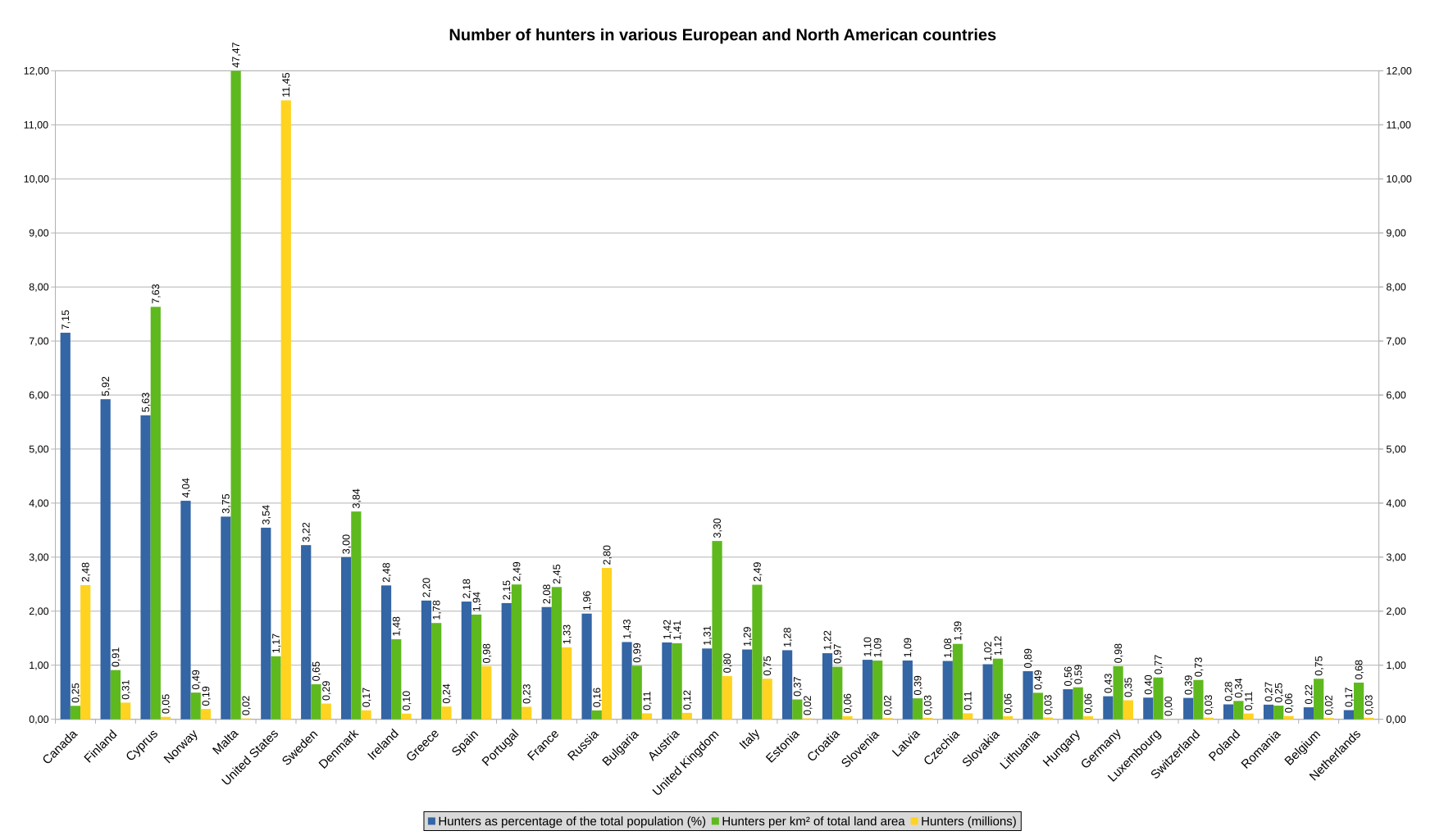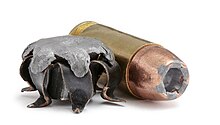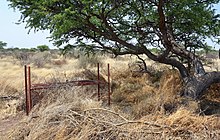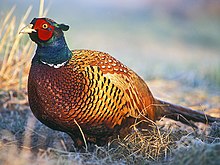Hunter on the stand during a driven hunt in Finland
Hunting is the practice of seeking, pursuing, and capturing or killing wild animals. Hunting wildlife or feral animals is most commonly done by humans for food, recreation, to remove predators that can be dangerous to humans or domestic animals, to remove pests that destroy crops or kill livestock, or for trade. Lawful hunting is distinguished from poaching, which is the illegal killing, trapping or capture of the hunted species. The species that are hunted are referred to as game or prey and are usually mammals and birds. In economic terms, hunting is considered to be part of the primary production alongside forestry, agriculture and fishing.
Bushmen hunter in Botswana
Hunting arose in Homo erectus
or earlier, on the order of millions of years ago. Hunting is deeply
embedded in human culture. Hunting an animal for its meat can also be
seen as a more natural way to obtain animal protein since regulated
hunting does not cause the same environmental issues as raising domestic
animals for meat, especially on factory farms.
Bow hunter in Utah
Hunting can also be a means of pest control. Hunting advocates state that hunting can be a necessary component of modern wildlife management, for example, to help maintain a population of healthy animals within an environment's ecological carrying capacity when natural checks such as predators are absent or very rare.
However, the usefulness of hunting as a control measure has been
questioned, and excessive hunting has also heavily contributed to the
endangerment, extirpation and extinction of many animals.
Professional deer stalker with red stag in Scotland
The pursuit, capture and release, or capture for food of fish is called fishing,
which is not commonly categorised as a form of hunting. It is also not
considered hunting to pursue animals without intent to kill them, as in wildlife photography, birdwatching, or scientific research activities which involve tranquilizing or tagging of animals or birds. The practice of foraging or gathering materials from plants and mushrooms is also considered separate from hunting.
Skillful tracking and acquisition of an elusive target has caused the word hunt to be used in the vernacular as a metaphor, as in treasure hunting, "bargain hunting", and even "hunting down" corruption and waste.
Some animal rights activists argue that hunting is cruel, unnecessary, and unethical.
Etymology
The word hunt serves as both a noun ("to be on a hunt") and a verb. The noun has been dated to the early 12th century, "act of chasing game," from the verb hunt. Old English had huntung, huntoþ.
The meaning of "a body of persons associated for the purpose of hunting
with a pack of hounds" is first recorded in the 1570s. Meaning "the act
of searching for someone or something" is from about 1600.
The verb, Old English huntian "to chase game" (transitive and intransitive), perhaps developed from hunta "hunter," is related to hentan "to seize," from Proto-Germanic huntojan (the source also of Gothic hinþan "to seize, capture," Old High German hunda "booty"), which is of uncertain origin. The general sense of "search diligently" (for anything) is first recorded c. 1200.
History
Lower to Middle Paleolithic
Hunting has a long history. It pre-dates the emergence of Homo sapiens (anatomically modern humans) and may even predate genus Homo.
The oldest undisputed evidence for hunting dates to the Early Pleistocene, consistent with the emergence and early dispersal of Homo erectus, about 1.7 million years ago (Acheulean).
While it is undisputed that Homo erectus were hunters, the importance of this for the emergence of Homo erectus from its australopithecine ancestors, including the production of stone tools and eventually the control of fire, is emphasised in the so-called "hunting hypothesis" and de-emphasised in scenarios that stress omnivory and social interaction.
There is no direct evidence for hunting predating Homo erectus, in either Homo habilis or in Australopithecus.
The early hominid ancestors of humans were probably frugivores or omnivores, with a partially carnivore diet from scavenging rather than hunting.
Evidence for australopithecine meat consumption was presented in the 1990s.
It has nevertheless often been assumed that at least occasional hunting
behavior may have been present well before the emergence of Homo.
This can be argued on the basis of comparison with chimpanzees,
the closest extant relatives of humans, who also engage in hunting,
indicating that the behavioral trait may have been present in the Chimpanzee–human last common ancestor as early as 5 million years ago. The common chimpanzee (Pan troglodytes) regularly engages in troop predation behaviour where bands of beta males are led by an alpha male. Bonobos (Pan paniscus) have also been observed to occasionally engage in group hunting, although more rarely than Pan troglodytes, mainly subsisting on a frugivorous diet.
Indirect evidence for Oldowan era hunting, by early Homo or late Australopithecus, has been presented in a 2009 study based on
an Oldowan site in southwestern Kenya.
Louis Binford
(1986) criticised the idea that early hominids and early humans were
hunters. On the basis of the analysis of the skeletal remains of the
consumed animals, he concluded that hominids and early humans were
mostly scavengers, not hunters,
Blumenschine (1986) proposed the idea of confrontational scavenging, which involves challenging and scaring off other predators after they have made a kill, which he suggests could have been the leading method of obtaining protein-rich meat by early humans.
Stone spearheads dated as early as 500,000 years ago were found in South Africa. Wood does not preserve well, however, and Craig Stanford, a primatologist and professor of anthropology at the University of Southern California,
has suggested that the discovery of spear use by chimpanzees probably
means that early humans used wooden spears as well, perhaps, five
million years ago.
The earliest dated find of surviving wooden hunting spears dates to the very end of the Lower Paleolithic, just before 300,000 years ago. The Schöningen spears, found in 1976 in Germany, are associated with Homo heidelbergensis.
The hunting hypothesis sees the emergence of behavioral modernity in the Middle Paleolithic as directly related to hunting, including mating behaviour, the establishment of language, culture, and religion, mythology and animal sacrifice.
Upper Paleolithic to Mesolithic
Saharan rock art with prehistoric archers
Evidence exists that hunting may have been one of the multiple environmental factors leading to the Holocene extinction of megafauna and their replacement by smaller herbivores.
North American megafauna extinction was coincidental with the Younger Dryas impact event, possibly making hunting a less critical factor in prehistoric species loss than had been previously thought.
However, in other locations such as Australia, humans are thought to
have played a very significant role in the extinction of the Australian megafauna that was widespread prior to human occupation.
Hunting was a crucial component of hunter-gatherer societies before the domestication of livestock and the dawn of agriculture, beginning about 11,000 years ago in some parts of the world. In addition to the spear, hunting weapons developed during the Upper Paleolithic include the atlatl (a spear-thrower; before 30,000 years ago) and the bow (18,000 years ago). By the Mesolithic, hunting strategies had diversified with the development of these more far-reaching weapons and the domestication of the dog about 15,000 years ago. Evidence puts the earliest known mammoth hunting in Asia with spears to approximately 16,200 years ago.
Sharp flint piece from Bjerlev Hede in central Jutland. Dated around 12,500 BC and considered the oldest hunting tool from Denmark
Many species of animals have been hunted throughout history. It has been suggested that in North America and Eurasia, caribou and wild reindeer "may well be the species of single greatest importance in the entire anthropological literature on hunting", although the varying importance of different species depended on the geographic location.
Ancient Greek black-figure pottery depicting the return of a hunter and his dog; made in Athens c. 540 BC, found in Rhodes
Mesolithic hunter-gathering lifestyles remained prevalent in some parts of the Americas, Sub-Saharan Africa, and Siberia, as well as all of Australia, until the European Age of Discovery. They still persist in some tribal societies, albeit in rapid decline. Peoples that preserved Paleolithic hunting-gathering until the recent past include some indigenous peoples of the Amazonas (Aché), some Central and Southern African (San people), some peoples of New Guinea (Fayu), the Mlabri of Thailand and Laos, the Vedda people of Sri Lanka, and a handful of uncontacted peoples. In Africa, one of the last remaining hunter-gatherer tribes are the Hadza of Tanzania.
Neolithic and Antiquity
Artemis with a Hind, a Roman copy of an Ancient Greek sculpture, c. 325 BC, by Leochares
An example of a Goguryeo tomb mural of hunting, middle of the first millennium
Even as animal domestication
became relatively widespread and after the development of agriculture,
hunting was usually a significant contributor to the human food supply.
The supplementary meat and materials from hunting included protein, bone for implements, sinew for cordage, fur, feathers, rawhide and leather used in clothing.
Hunting is still vital in marginal climates, especially those unsuited for pastoral uses or agriculture. For example, Inuit people in the Arctic trap and hunt animals for clothing and use the skins of sea mammals to make kayaks, clothing, and footwear.
On ancient reliefs, especially from Mesopotamia, kings are often depicted as hunters of big game such as lions and are often portrayed hunting from a war chariot. The cultural and psychological importance of hunting in ancient societies is represented by deities such as the horned god Cernunnos and lunar goddesses of classical antiquity, the Greek Artemis or Roman Diana. Taboos are often related to hunting, and mythological association of prey species with a divinity could be reflected in hunting restrictions such as a reserve surrounding a temple. Euripides' tale of Artemis and Actaeon, for example, may be seen as a caution against disrespect of prey or impudent boasting.
With the domestication of the dog, birds of prey, and the ferret, various forms of animal-aided hunting developed, including venery (scent hound hunting, such as fox hunting), coursing (sight hound hunting), falconry, and ferreting. While these are all associated with medieval hunting, over time, various dog breeds were selected for very precise tasks during the hunt, reflected in such names as pointer and setter.
Pastoral and agricultural societies
Even as agriculture and animal husbandry
became more prevalent, hunting often remained as a part of human
culture where the environment and social conditions allowed.
Hunter-gatherer societies persisted, even when increasingly confined to
marginal areas. And within agricultural systems, hunting served to kill
animals that prey upon domestic and wild animals or to attempt to extirpate animals seen by humans as competition for resources such as water or forage.
When hunting moved from a subsistence activity to a social one, two trends emerged:
- the development of the role of the specialist hunter, with special training and equipment
- the co-option of hunting as a "sport" for those of an upper social class
The meaning of the word game in Middle English
evolved to include an animal which is hunted. As game became more of a
luxury than a necessity, the stylised pursuit of it also became a
luxury. Dangerous hunting, such as for lions or wild boars, often done on horseback or from a chariot, had a function similar to tournaments and manly sports. Hunting ranked as an honourable, somewhat competitive pastime to help the aristocracy practice skills of war in times of peace.
In most parts of medieval
Europe, the upper class obtained the sole rights to hunt in certain
areas of a feudal territory. Game in these areas was used as a source of
food and furs, often provided via professional huntsmen, but it was
also expected to provide a form of recreation for the aristocracy. The
importance of this proprietary view of game can be seen in the Robin Hood
legends, in which one of the primary charges against the outlaws is
that they "hunt the King's deer". In contrast, settlers in Anglophone
colonies gloried democratically in hunting for all.
In Medieval Europe, hunting was considered by Johannes Scotus Eriugena to be part of the set of seven mechanical arts.
Use of dog
Although various other animals have been used to aid the hunter, such
as ferrets, the dog has assumed many very important uses to the hunter.
The domestication of the dog has led to a symbiotic relationship
in which the dog's independence from humans is deferred. Though dogs
can survive independently of humans, and in many cases do, as with feral
dogs, where hunger is not a primary factor, the species tends to defer
to human control in exchange for habitation, food and support.
Dogs today are used to find, chase, retrieve, and sometimes to kill the game. Hunting dogs
allow humans to pursue and kill prey that would otherwise be very
difficult or dangerous to hunt. Different breeds of dogs are used for
different types of hunting. Waterfowl are commonly hunted using
retrieving dogs such as the Labrador Retriever, the Golden Retriever, the Chesapeake Bay Retriever, the Brittany Spaniel, and other similar breeds. Game birds are flushed out using flushing spaniels such as the English Springer Spaniel, the various Cocker Spaniels and similar breeds.
Religion
Many prehistoric deities are depicted as predators or prey of humans, often in a zoomorphic form, perhaps alluding to the importance of hunting for most Palaeolithic cultures.
In many pagan religions, specific rituals are conducted before or
after a hunt; the rituals done may vary according to the species hunted
or the season the hunt is taking place. Often a hunting ground, or the hunt for one or more species, was reserved or prohibited in the context of a temple cult.
Mughal aristocrats hunting a blackbuck alongside an Asiatic cheetah, 1812
Indian and Eastern religions
A group of Sikhs hunting (Unknown Pahari artist, 18th century)
A tiger hunt at Jhajjar, Rohtak District, Punjab, c. 1820
Hindu scriptures
describe hunting as an acceptable occupation, as well as a sport of the
kingly. Even figures considered divine are described to have engaged in
hunting. One of the names of the god Shiva is Mrigavyadha, which translates as "the deer hunter" (mriga means deer; vyadha means hunter). The word Mriga,
in many Indian languages including Malayalam, not only stands for deer,
but for all animals and animal instincts (Mriga Thrishna). Shiva, as
Mrigavyadha, is the one who destroys the animal instincts in human
beings. In the epic Ramayana, Dasharatha, the father of Rama, is said to have the ability to hunt in the dark. During one of his hunting expeditions, he accidentally killed Shravana, mistaking him for game. During Rama's exile in the forest, Ravana kidnapped his wife, Sita, from their hut, while Rama was asked by Sita to capture a golden deer, and his brother Lakshman went after him. According to the Mahabharat, Pandu, the father of the Pandavas, accidentally killed the sage Kindama and his wife with an arrow, mistaking them for a deer. Krishna is said to have died after being accidentally wounded by an arrow of a hunter.
Jainism
teaches followers to have tremendous respect for all of life.
Prohibitions for hunting and meat eating are the fundamental conditions
for being a Jain.
Buddhism's first precept is the respect for all sentient life. The general approach by all Buddhists is to avoid killing any living animals. Buddha explained the issue by saying "all fear death; comparing others with oneself, one should neither kill nor cause to kill."
In Sikhism, only meat obtained from hunting, or slaughtered with the Jhatka is permitted. The Sikh gurus, especially Guru Hargobind and Guru Gobind Singh were ardent hunters. Many old Sikh Rehatnamas like Prem Sumarag, recommend hunting wild boar and deer. However, among modern Sikhs, the practise of hunting has died down; some even saying that all meat is forbidden.
Christianity, Judaism, and Islam
Ladies hunting in the 15th century
Tapestry with a hunting scene, late 16th century
From early Christian times, hunting has been forbidden to Roman Catholic Church clerics. Thus the Corpus Juris Canonici
(C. ii, X, De cleric. venat.) says, "We forbid to all servants of God
hunting and expeditions through the woods with hounds; and we also
forbid them to keep hawks or falcons." The Fourth Council of the Lateran, held under Pope Innocent III, decreed (canon xv): "We interdict hunting or hawking to all clerics." The decree of the Council of Trent
is worded more mildly: "Let clerics abstain from illicit hunting and
hawking" (Sess. XXIV, De reform., c. xii), which seems to imply that not
all hunting is illicit, and canonists generally make a distinction
declaring noisy (clamorosa) hunting unlawful, but not quiet (quieta) hunting.
Ferraris (s.v. "Clericus", art. 6) gives it as the general sense
of canonists that hunting is allowed to clerics if it be indulged in
rarely and for sufficient cause, as necessity, utility or "honest"
recreation, and with that moderation which is becoming to the ecclesiastical state.
Ziegler, however (De episc., l. IV, c. xix), thinks that the
interpretation of the canonists is not in accordance with the letter or
spirit of the laws of the church.
Nevertheless, although a distinction between lawful and unlawful
hunting is undoubtedly permissible, it is certain that a bishop can
absolutely prohibit all hunting to the clerics of his diocese, as was
done by synods at Milan, Avignon, Liège, Cologne, and elsewhere. Benedict XIV
(De synodo diœces., l. II, c. x) declared that such synodal decrees are
not too severe, as an absolute prohibition of hunting is more
conformable to the ecclesiastical law.
In practice, therefore, the synodal statutes of various localities must
be consulted to discover whether they allow quiet hunting or prohibit
it altogether.
It is important to note that most Christian, do not observe kosher dietary laws hence most Christian have no religious restrictions on eating the animals hunted. This is in accord with what is found in the Acts of the Apostles 15:28–29, and 1 Timothy 4:4.
In Jewish law hunting is not forbidden although there is an aversion to it. The great 18th-century authority Rabbi Yechezkel Landau
after a study concluded although "hunting would not be considered
cruelty to animals insofar as the animal is generally killed quickly and
not tortured... There is an unseemly element in it, namely cruelty."
The other issue is that hunting can be dangerous and Judaism places an
extreme emphasis on the value of human life.
Islamic Sharia Law permits hunting of lawful animals and birds if they cannot be easily caught and slaughtered.
National traditions
New Zealand
New Zealand has a strong hunting culture.
When humans arrived, the only mammals present on the islands making up
New Zealand were bats, although seals and other marine mammals were
present along the coasts. However, when humans arrived they brought
other species with them. Polynesian voyagers introduced kuri (dogs),
kiore (Polynesian rats), as well as a range of plant species. European
explorers further added to New Zealand's biota, particularly pigs which
were introduced by either Captain Cook or the French explorer De
Surville in the 1700s. During the nineteenth century, as European colonisation took place, acclimatisation societies were established. The societies introduced a large number of species with no use other than as prey for hunting. Species that adapted well to the New Zealand terrain include deer, pigs, goats, hare, tahr and chamois.
With wilderness areas, suitable forage, and no natural predators, their
populations exploded. Government agencies view the animals as pests due
to their effects on the natural environment and on agricultural production, but hunters view them as a resource.
Weeks Edwin's painting Departure for the Hunt, c. 1885
Shikar (Indian subcontinent)
A Shikar party in Mandalay, Burma, soon after the conclusion of the Third Anglo-Burmese War in 1886, when Burma was annexed to British India
During the feudal and colonial times in British India, hunting was regarded as a regal sport in the numerous princely states, as many maharajas and nawabs, as well as British officers, maintained a whole corps of shikaris (big-game hunters), who were native professional hunters. They would be headed by a master of the hunt, who might be styled mir-shikar. Often, they recruited the normally low-ranking local tribes because of their traditional knowledge of the environment and hunting techniques. Big game, such as Bengal tigers, might be hunted from the back of an elephant.
Regional social norms are generally antagonistic to hunting, while a few sects, such as the Bishnoi, lay special emphasis on the conservation of particular species, such as the antelope. India's Wildlife Protection Act of 1972
bans the killing of all wild animals. However, the Chief Wildlife
Warden may, if satisfied that any wild animal from a specified list has
become dangerous to human life, or is so disabled or diseased as to be
beyond recovery, permit any person to hunt such an animal. In this case,
the body of any wild animal killed or wounded becomes government
property.
Safari
Explorer and big game hunter Samuel Baker chased by an elephant, illustration from 1890
A safari, from a Swahili
word meaning "a long journey", especially in Africa, is defined as an
overland journey. Safari as a distinctive way of hunting was popularised
by the US author Ernest Hemingway and President Theodore Roosevelt. A safari may consist of a several-days – or even weeks-long journey, with camping in the bush or jungle, while pursuing big game. Nowadays, it is often used to describe tours through African national parks to watch or hunt wildlife.Hunters are usually tourists, accompanied by licensed and highly regulated professional hunters, local guides, skinners, and porters
in more difficult terrains. A special safari type is the solo-safari,
where all the license acquiring, stalking, preparation, and outfitting
is done by the hunter himself.
United Kingdom
Snowden Slights with retriever and shotgun around 1910, 'the last of Yorkshire's Wildfowlers'
Unarmed fox hunting
on horseback with hounds is the type of hunting most closely associated
with the United Kingdom; in fact, "hunting" without qualification
implies fox hunting. What in other countries is called "hunting" is
called "shooting" (birds) or "stalking" (deer) in Britain. Originally a
form of vermin control to protect livestock, fox hunting became a popular social activity for newly wealthy upper classes in Victorian times
and a traditional rural activity for riders and foot followers alike.
Similar to fox hunting in many ways is the chasing of hares with hounds. Pairs of Sight hounds (or long-dogs), such as greyhounds,
may be used to pursue a hare in coursing, where the greyhounds are
marked as to their skill in coursing the hare (but are not intended to
actually catch it), or the hare may be pursued with scent hounds such as beagles or harriers. Other sorts of foxhounds may also be used for hunting stags (deer) or mink. Deer stalking with rifles is carried out on foot without hounds, using stealth.
These forms of hunting have been controversial in the UK. Animal welfare
supporters believe that hunting causes unnecessary suffering to foxes,
horses, and hounds. Proponents argue that it is culturally and perhaps
economically important. Using dogs to chase wild mammals was made illegal in February 2005 by the Hunting Act 2004;
there were a number of exemptions (under which the activity may not be
illegal) in the act for hunting with hounds, but no exemptions at all
for hare-coursing.
Shooting traditions
Game birds, especially pheasants, are shot with shotguns for sport in the UK; the British Association for Shooting and Conservation says that over a million people per year participate in shooting, including game shooting, clay pigeon shooting, and target shooting.
Shooting as practised in Britain, as opposed to traditional hunting,
requires little questing for game—around thirty-five million birds are
released onto shooting estates every year, some having been factory farmed.
Shoots can be elaborate affairs with guns placed in assigned positions
and assistants to help load shotguns. When in position, "beaters" move
through the areas of cover, swinging sticks or flags to drive the game
out. Such events are often called "drives". The open season for grouse in the UK begins on 12 August, the so-called Glorious Twelfth. The definition of game in the United Kingdom is governed by the Game Act 1831.
A similar tradition exists in Spain.
United States
This section needs additional citations for verification. (December 2019) (Learn how and when to remove this template message)
|
Hunting camp with dressed deer at Schoodic Lake, Maine, in 1905
North American hunting pre-dates the United States by thousands of years and was an important part of many pre-Columbian
Native American cultures. Native Americans retain some hunting rights
and are exempt from some laws as part of Indian treaties and otherwise
under federal law—examples include eagle feather laws and exemptions in the Marine Mammal Protection Act. This is considered particularly important in Alaskan native communities.
Hunting is primarily regulated by state law; additional regulations are imposed through United States environmental law in the case of migratory birds and endangered species.
Regulations vary widely from state to state and govern the areas, time
periods, techniques and methods by which specific game animals may be
hunted. Some states make a distinction between protected species and unprotected species (often vermin or varmints for which there are no hunting regulations). Hunters of protected species require a hunting license in all states, for which completion of a hunting safety course is sometimes a prerequisite.
Typically, game animals are divided into several categories for
regulatory purposes. Typical categories, along with example species, are
as follows:
- Big game: white-tailed deer, mule deer, moose, elk, caribou, bear, bighorn sheep, pronghorn, boar, javelina, bison
- Small game: rabbit, hare, squirrel, opossum, raccoon, porcupine, skunk, ring-tailed cat, armadillo, ruffed grouse
- Furbearers: beaver, red fox, mink, pine marten, musk rat, otter, bobcat, coyote
- Predators: cougar (mountain lion and panther), wolf, coyote
- Upland game bird: grouse, woodcock, chukar, pheasant, quail, dove
- Waterfowl: duck, teal, merganser, geese, swan
Hunting big game typically requires a "tag" for each animal
harvested. Tags must be purchased in addition to the hunting license,
and the number of tags issued to an individual is typically limited. In
cases where there are more prospective hunters than the quota for that
species, tags are usually assigned by lottery. Tags may be further
restricted to a specific area, or wildlife management unit. Hunting migratory waterfowl requires a duck stamp from the Fish and Wildlife Service in addition to the appropriate state hunting license.
Harvest of animals other than big game is typically restricted by
a bag limit and a possession limit. A bag limit is the maximum number
of a specific animal species that an individual can harvest in a single
day. A possession limit is the maximum number of a specific animal
species that can be in an individual's possession at any time.
Shooting
A man target practicing for the hunting seasons
Gun usage in hunting is typically regulated by game category, area within the state, and time period. Regulations for big-game hunting often specify a minimum caliber or muzzle energy for firearms. The use of rifles is often banned for safety reasons in areas with high population densities or limited topographic relief. Regulations may also limit or ban the use of lead in ammunition because of environmental concerns. Specific seasons for bow hunting or muzzle-loading black-powder guns are often established to limit competition with hunters using more effective weapons.
Hunting in the United States is not associated with any
particular class or culture; a 2006 poll showed seventy-eight percent of
Americans supported legal hunting, although relatively few Americans actually hunt. At the beginning of the 21st century, just six percent of Americans hunted. Southerners
in states along the eastern seaboard hunted at a rate of five percent,
slightly below the national average, and while hunting was more common
in other parts of the South at nine percent, these rates did not surpass
those of the Plains states, where twelve percent of Midwesterners hunted. Hunting in other areas of the country fell below the national average.
Overall, in the 1996–2006 period, the number of hunters over the age of
sixteen declined by ten percent, a drop attributable to a number of
factors including habitat loss and changes in recreation habits.
Regulation
Regulation of hunting within the United States dates from the 19th century. Some modern hunters see themselves as conservationists and sportsmen in the mode of Theodore Roosevelt and the Boone and Crockett Club.
Local hunting clubs and national organizations provide hunter education
and help protect the future of the sport by buying land for future
hunting use. Some groups represent a specific hunting interest, such as Ducks Unlimited, Pheasants Forever, or the Delta Waterfowl Foundation. Many hunting groups also participate in lobbying the federal government and state government.
Each year, nearly $200 million in hunters' federal excise taxes
are distributed to state agencies to support wildlife management
programs, the purchase of lands open to hunters, and hunter education
and safety classes. Since 1934, the sale of Federal Duck Stamps, a required purchase for migratory waterfowl hunters over sixteen years old, has raised over $700 million to help purchase more than 5,200,000 acres (8,100 sq mi; 21,000 km2) of habitat for the National Wildlife Refuge System
lands that support waterfowl and many other wildlife species and are
often open to hunting. States also collect money from hunting licenses
to assist with management of game animals, as designated by law. A key
task of federal and state park rangers and game wardens is to enforce laws and regulations related to hunting, including species protection, hunting seasons, and hunting bans.
Varmint hunting
The coypu is hunted as a pest in Louisiana.
Varmint hunting is an American phrase for the selective killing of
non-game animals seen as pests. While not always an efficient form of pest control,
varmint hunting achieves selective control of pests while providing
recreation and is much less regulated. Varmint species are often
responsible for detrimental effects on crops, livestock, landscaping, infrastructure,
and pets. Some animals, such as wild rabbits or squirrels, may be
utilised for fur or meat, but often no use is made of the carcass. Which
species are varmints depends on the circumstance and area. Common
varmints may include various rodents, coyotes, crows, foxes, feral cats, and feral hogs. Some animals once considered varmints are now protected, such as wolves. In the US state of Louisiana, a non-native rodent, the coypu, has become so destructive to the local ecosystem that the state has initiated a bounty program to help control the population.
Fair chase
The principles of the fair chase
have been a part of the American hunting tradition for over one hundred
years. The role of the hunter-conservationist, popularised by Theodore
Roosevelt, and perpetuated by Roosevelt's formation of the Boone and Crockett Club, has been central to the development of the modern fair chase tradition. Beyond Fair Chase: The Ethic and Tradition of Hunting, a book by Jim Posewitz, describes fair chase:
"Fundamental to ethical hunting is the idea of fair chase. This concept addresses the balance between the hunter and the hunted. It is a balance that allows hunters to occasionally succeed while animals generally avoid being taken."
When Internet hunting
was introduced in 2005, allowing people to hunt over the Internet using
remotely controlled guns, the practice was widely criticised by hunters
as violating the principles of fair chase. As a representative of the National Rifle Association
(NRA) explained, "The NRA has always maintained that fair chase, being
in the field with your firearm or bow, is an important element of
hunting tradition. Sitting at your desk in front of your computer,
clicking at a mouse, has nothing to do with hunting."
Hunters with an American black bear in the Great Smoky Mountains
One hunting club declares that a fair chase shall not involve the taking of animals under the following conditions:
- Helpless in a trap, deep snow or water, or on ice.
- From any power vehicle or power boat.
- By "jacklighting" or shining at night.
- By the use of any tranquilizers or poisons.
- While inside escape-proof fenced enclosures.
- By the use of any power vehicle or power boat for herding or driving animals, including use of aircraft to land alongside or to communicate with or direct a hunter on the ground.
- By the use of electronic devices for attracting, locating or
pursuing game or guiding the hunter to such game, or by the use of a bow
or arrow to which any electronic device is attached.
Ranches
Indian blackbuck, nilgai, axis deer, fallow deer, zebras, barasingha and many other exotics can now be found on hunting ranches
in Texas, where they were introduced for sport hunting. These hunters
can be found paying in excess of $10,000 dollars to take trophy animals
on these controlled ranches.
Russia
The Russian imperial hunts evolved from hunting traditions of early Russian rulers—Grand Princes and Tsars—under the influence of hunting customs of European royal courts. The imperial hunts were organised mainly in Peterhof, Tsarskoye Selo, and Gatchina.
Riders gather for a dingo drive in Morven, Queensland, 1936
Australia
Hunting in Australia
has evolved around the hunting and eradication of various animals
considered to be pests. All native animals are protected by law, and can
only be killed under a special permit. Hunted introduced species
include deer, pigs, goats, foxes, and rabbits.
Japan
The numbers of licensed hunters in Japan, including those using snares and guns, is generally decreasing, while their average age is increasing. As of 2010, there were approximately 190,000 registered hunters, approximately 65% of whom were sixty years old or older.
Trinidad and Tobago
There is a very active tradition of hunting of small to medium-sized wild game in Trinidad and Tobago.
Hunting is carried out with firearms, and aided by the use of hounds,
with the illegal use of trap guns and snare nets. With approximately
12,000 sport hunters applying for hunting permits in recent years (in a
very small country of about the size of the state of Delaware at about
5128 square kilometers and 1.3 million inhabitants), there is some
concern that the practice might not be sustainable. In addition there
are at present no bag limits and the open season is comparatively very
long (5 months – October to February inclusive). As such hunting
pressure from legal hunters is very high. Added to that, there is a
thriving and very lucrative black market for poached wild game (sold and
enthusiastically purchased as expensive luxury delicacies) and the
numbers of commercial poachers in operation is unknown but presumed to
be fairly high. As a result, the populations of the five major mammalian
game species (red-rumped agouti, lowland paca, nine-banded armadillo, collared peccary, and red brocket deer)
are thought to be quite low (although scientifically conducted
population studies are only just recently being conducted as of 2013).
It appears that the red brocket deer population has been extirpated on
Tobago as a result of over-hunting. Various herons, ducks, doves, the green iguana, the gold tegu, the spectacled caiman and the common opossum are also commonly hunted and poached. There is also some poaching of 'fully protected species', including red howler monkeys and capuchin monkeys, southern tamanduas, Brazilian porcupines, yellow-footed tortoises, Trinidad piping guans and even one of the national birds, the scarlet ibis.
Legal hunters pay very small fees to obtain hunting licences and
undergo no official basic conservation biology or hunting-ethics
training. There is presumed to be relatively very little subsistence
hunting in the country (with most hunting for either sport or commercial
profit). The local wildlife management authority is under-staffed and
under-funded, and as such very little in the way of enforcement is done
to uphold existing wildlife management laws, with hunting occurring both
in and out of season, and even in wildlife sanctuaries. There is some
indication that the government is beginning to take the issue of
wildlife management more seriously, with well drafted legislation being
brought before Parliament in 2015. It remains to be seen if the drafted
legislation will be fully adopted and financially supported by the
current and future governments, and if the general populace will move
towards a greater awareness of the importance of wildlife conservation
and change the culture of wanton consumption to one of sustainable
management.
Wildlife management
Hunting is claimed to give resource managers an important tool in managing populations that might exceed the carrying capacity of their habitat and threaten the well-being of other species, or, in some instances, damage human health or safety.
In some cases, hunting actually can increase the population of
predators such as coyotes by removing territorial bounds that would
otherwise be established, resulting in excess neighbouring migrations
into an area, thus artificially increasing the population. Hunting advocates assert that hunting reduces intraspecific competition for food and shelter, reducing mortality among the remaining animals. Some environmentalists assert that (re)introducing predators would achieve the same end with greater efficiency and less negative effect, such as introducing significant amounts of free lead into the environment and food chain.
In the United States, wildlife managers are frequently part of
hunting regulatory and licensing bodies, where they help to set rules on
the number, manner and conditions in which game may be hunted.
Management agencies sometimes rely on hunting to control specific
animal populations, as has been the case with deer in North America.
These hunts may sometimes be carried out by professional shooters,
although others may include amateur hunters. Many US city and local
governments hire professional and amateur hunters each year to reduce
populations of animals such as deer that are becoming hazardous in a
restricted area, such as neighbourhood parks and metropolitan open spaces.
A large part of managing populations involves managing the number
and, sometimes, the size or age of animals harvested so as to ensure
the sustainability of the population. Tools that are frequently used to
control harvest are bag limits and season closures, although gear
restrictions such as archery-only seasons are becoming increasingly
popular in an effort to reduce hunter success rates in countries that
rely on bag limits per hunter instead of per area.
Laws
Illegal hunting and harvesting of wild species contrary to local and international conservation and wildlife management laws is called poaching. Game preservation
is one of the tactics used to prevent poaching. Violations of hunting
laws and regulations involving poaching are normally punishable by law. Punishment can include confiscation of equipment, fines, or a prison sentence.
Right to hunt
The right to hunt − sometimes in combination with the right to fish − is protected implicitly, as a consequence of the right of ownership, or explicitly, as a right on its own,
in a number of jurisdictions. For instance, as of 2019, a total of 22
U.S. states explicitly recognize a subjective right to hunt in their
constitutions.
Bag limits
Red-legged partridges on a game rack
Bag limits are provisions under the law that control how many animals
of a given species or group of species can be killed, although there
are often species for which bag limits do not apply. There are also jurisdictions where bag limits are not applied at all or are not applied under certain circumstances. The phrase bag limits comes from the custom among hunters of small game to carry successful kills in a small basket, similar to a fishing creel.
Where bag limits are used, there can be daily or seasonal bag
limits; for example, ducks can often be harvested at a rate of six per
hunter per day. Big game, like moose, most often have a seasonal bag limit of one animal per hunter.
Bag limits may also regulate the size, sex, or age of animal that a
hunter can kill. In many cases, bag limits are designed to allocate
harvest among the hunting population more equitably rather than to
protect animal populations, as protecting the population would
necessitate regional density-dependent maximum bags.
Closed and open season
A closed season
is a time during which hunting an animal of a given species is contrary
to law. Typically, closed seasons are designed to protect a species
when they are most vulnerable or to protect them during their breeding season. By extension, the period that is not the closed season is known as the open season.
Methods
Africans hunting the lion, 1841
American bison being chased off a cliff as seen and painted by Alfred Jacob Miller, c. 1860
Master
or whipper-in and fox hounds drawing a wood. Hunting in Yorkshire,
northern England, in 2005, on the last day of fully legal, proper, fox
hunting.
Historical, subsistence, and sport hunting techniques can differ
radically, with modern hunting regulations often addressing issues of
where, when, and how hunts are conducted. Techniques may vary depending
on government regulations, a hunter's personal ethics, local custom,
hunting equipment, and the animal being hunted. Often a hunter will use a
combination of more than one technique. Laws may forbid sport hunters
from using some methods used primarily in poaching and wildlife
management.
- Baiting is the use of decoys, lures, scent, or food.
- Battue involves scaring animals (by beating sticks) into a killing zone or ambush.
- Beagling is the use of beagles in hunting rabbits, and sometimes in hunting foxes.
- Beating uses human beaters to flush out game from an area or drive it into position.
- Stand hunting or blind hunting is waiting for animals from a concealed or elevated position, for example from tree stands, hunting blinds or other types of shooting stands.
- Calling is the use of animal noises to attract or drive animals.
- Camouflage is the use of visual or odour concealment to blend with the environment.
- Dogs may be used to course or to help flush, herd, drive, track, point at, pursue, or retrieve prey.
- Driving is the herding of animals in a particular direction, usually toward another hunter in the group.
- Flushing is the practice of scaring animals from concealed areas.
- Ghillie suit is a type of gear a person can wear to blend with environment.
- Glassing is the use of optics, such as binoculars, to locate animals more easily.
- Glue is an indiscriminate passive form to kill birds.
- Internet hunting is a method of hunting over the Internet using webcams and remotely controlled guns.
- Netting involves using nets, including active netting with the use of cannon nets and rocket nets.
- Persistence hunting is the use of running and tracking to pursue the prey to exhaustion.
- Posting is done by sitting or standing in a particular place with the intentions of intercepting your game of choice along their travel corridor.
- Scouting for game is typically done prior to a hunt and will ensure the desired species are in a chosen area. Looking for animal sign such as tracks, scat, etc.... and utilizing "trail cameras" are commonly used tactics while scouting.
- Shooting is the use of a ranged weapon such as a gun, bow, crossbow, or slingshot.
- Solunar theory says that animals move according to the location of the moon in comparison to their bodies and is said to have been used long before this by hunters to know the best times to hunt their desired game.
- Spotlighting or shining is the use of artificial light to find or blind animals before killing.
- Stalking or still hunting is the practice of walking quietly in search of animals or in pursuit of an individual animal.
- Tracking is the practice of reading physical evidence in pursuing animals.
- Trapping is the use of devices such as snares, pits, and deadfalls to capture or kill an animal.
Statistics
Table
| Country | Hunters | Population
(millions)
|
Hunters as percentage of
the total population (%)
|
Relation
hunters/inhabitants
|
Area (km2) | Hunters per km2 |
|---|---|---|---|---|---|---|
| 350,000 | 4.2 | 8.33 | 1:12 | 70,273 | 8.33 | |
| 2,482,678 | 34.7 | 7.15 | 1:14 | 9,984,670 | 0.25 | |
| 308,000 | 5.2 | 5.92 | 1:17 | 338,448 | 0.91 | |
| 45,000 | 0.8 | 5.63 | 1:18 | 5,896 | 7.63 | |
| 190,000 | 4.7 | 4.04 | 1:25 | 385,207 | 0.49 | |
| 15,000 | 0.4 | 3.75 | 1:27 | 316 | 47.47 | |
| 11,453,000 | 323.1 | 3.54 | 1:28 | 9,826,675 | 1.17 | |
| 290,000 | 9.0 | 3.22 | 1:31 | 447,435 | 0.65 | |
| 165,000 | 5.5 | 3.00 | 1:33 | 42,921 | 3.84 | |
| 980,000 | 40.5 | 2.42 | 1:41 | 505,970 | 1.94 | |
| 235,000 | 10.7 | 2.20 | 1:46 | 131,957 | 1.78 | |
| 230,000 | 10.7 | 2.15 | 1:47 | 92,212 | 2.49 | |
| 1,331,000 | 64.1 | 2.08 | 1:48 | 543,965 | 2.45 | |
| 2,800,000 | 143.2 | 1.96 | 1:51 | 17,125,200 | 0.16 | |
| 110,000 | 7.7 | 1.43 | 1:70 | 110,994 | 0.99 | |
| 118,000 | 8.3 | 1.42 | 1:70 | 83,879 | 1.41 | |
| 800,000 | 61.1 | 1.31 | 1:76 | 242,495 | 3.30 | |
| 750,000 | 58.1 | 1.29 | 1:77 | 301,338 | 2.49 | |
| 16,600 | 1.3 | 1.28 | 1:78 | 45,339 | 0.37 | |
| 55,000 | 4.5 | 1.22 | 1:82 | 56,594 | 0.97 | |
| 22,000 | 2.0 | 1.10 | 1:91 | 20,273 | 1.09 | |
| 25,000 | 2.3 | 1.09 | 1:92 | 64,589 | 0.39 | |
| 110,000 | 10.2 | 1.08 | 1:93 | 78,866 | 1.39 | |
| 55,000 | 5.4 | 1.02 | 1:98 | 49,034 | 1.12 | |
| 32,000 | 3.6 | 0.89 | 1:113 | 65,300 | 0.49 | |
| 55,000 | 9.9 | 0.56 | 1:180 | 93,036 | 0.59 | |
| 351,000 | 82.5 | 0.43 | 1:235 | 357,578 | 0.98 | |
| 2,000 | 0.5 | 0.40 | 1:250 | 2,586 | 0.77 | |
| 30,000 | 7.6 | 0.39 | 1:253 | 41,285 | 0.73 | |
| 106,000 | 38.5 | 0.28 | 1:363 | 312,696 | 0.34 | |
| 60,000 | 22.2 | 0.27 | 1:370 | 238,391 | 0.25 | |
| 23,000 | 10.4 | 0.22 | 1:452 | 30,688 | 0.75 | |
| 28,170 | 16.7 | 0.17 | 1:593 | 41,543 | 0.68 |
Graph
Trophy hunting
Trophy collection of the Princely Family of Liechtenstein at Úsov Château, the Czech Republic
Trophy hunting is the selective seeking of wild game. It may also
include the controversial hunting of captive or semi-captive animals
expressly bred and raised under controlled or semi-controlled conditions
so as to attain trophy characteristics; this is sometimes known as canned hunts.
History
In the 19th century, southern and central European sport hunters often pursued game only for a trophy, usually the head or pelt
of an animal, which was then displayed as a sign of prowess. The rest
of the animal was typically discarded. Some cultures, however,
disapprove of such waste. In Nordic countries,
hunting for trophies was—and still is—frowned upon. Hunting in North
America in the 19th century was done primarily as a way to supplement
food supplies, although it is now undertaken mainly for sport. The safari
method of hunting was a development of sport hunting that saw elaborate
travel in Africa, India and other places in pursuit of trophies. In
modern times, trophy hunting persists and is a significant industry in some areas.
Conservation tool
According to the U.S. Fish and Wildlife Service,
hunting "provides an economic incentive" for ranchers to continue to
breed those species, and that hunting "reduces the threat of the
species' extinction."
A scientific study in the journal, Biological Conservation,
states that trophy hunting is of "major importance to conservation in
Africa by creating economic incentives for conservation over vast areas,
including areas which may be unsuitable for alternative wildlife-based
land uses such as photographic ecotourism."
However, another study states that less than 3% of a trophy hunters'
expenditures reach the local level, meaning that the economic incentive
and benefit is "minimal, particularly when we consider the vast areas of
land that hunting concessions occupy."
Financial incentives from trophy hunting effectively more than
double the land area that is used for wildlife conservation, relative to
what would be conserved relying on national parks alone according to Biological Conservation, although local communities usually derive no more than 18 cents per hectare from trophy hunting.
Trophy hunting has been considered essential for providing economic incentives to conserve large carnivores according to research studies in Conservation Biology, Journal of Sustainable Tourism, Wildlife Conservation by Sustainable Use, and Animal Conservation. Studies by the Centre for Responsible Tourism
and the IUCN state that ecotourism, which includes more than hunting,
is a superior economic incentive, generating twice the revenue per acre
and 39 times more permanent employment. At the crosssection of trophy hunting, ecotourism and conservation is green hunting, a trophy hunting alternative where hunters pay to dart animals that need to be tranquilized for conservation projects.
The U.S. House Committee on Natural Resources in 2016 concluded that trophy hunting may be contributing to the extinction of certain animals. Conservationist groups such as IFAW assert that trophy hunting is a key factor in the "silent extinction" of giraffes.
According to a national survey that the U.S. Fish and Wildlife
Service conducts every five years, fewer people are hunting, even as
population rises. National Public Radio reported, a graph shows 2016
statistics, that only about 5 percent of Americans, 16 years old and
older, actually hunt, which is half of what it was 50 years ago. The
decline in popularity of hunting is expected to accelerate over the next
decade, which threatens how US will pay for conservation.
Controversy
Trophy hunting is most often criticised when it involves rare or endangered animals. Opponents may also see trophy hunting as an issue of morality or animal cruelty, criticising the killing of living creatures for recreation. Victorian era dramatist W. S. Gilbert remarked, "Deer-stalking would be a very fine sport if only the deer had guns."
There is also debate about the extent to which trophy hunting benefits the local economy.
Hunters argue that fees paid contribute to the local economy and
provide value to animals that would otherwise be seen as competition for
grazing, livestock, and crops. This analysis is disputed by many conservationist organizations and other opponents of trophy hunting. It is argued that the animals are worth more to the community for ecotourism than hunting.
Economics
Chatelherault, built by William Adam in 1743 as the Duke of Hamilton's hunting lodge
A variety of industries benefit from hunting and support hunting on economic grounds. In Tanzania, it is estimated that a safari hunter spends fifty to one hundred times that of the average ecotourist.
While the average photo tourist may seek luxury accommodation, the
average safari hunter generally stays in tented camps. Safari hunters
are also more likely to use remote areas, uninviting to the typical
ecotourist. Advocates argue that these hunters allow for anti-poaching
activities and revenue for local communities.
In the United Kingdom, the game hunting of birds as an industry
is said to be extremely important to the rural economy. The Cobham
Report of 1997 suggested it to be worth around £700 million, and hunting
and shooting lobby groups claimed it to be worth over a billion pounds
less than ten years later.
Hunting also has a significant financial impact in the United States, with many companies specialising in hunting equipment
or speciality tourism. Many different technologies have been created to
assist hunters, even including iPhone applications. Today's hunters
come from a broad range of economic, social, and cultural backgrounds.
In 2001, over thirteen million hunters averaged eighteen days hunting,
and spent over $20.5 billion on their sport.
In the US, proceeds from hunting licenses contribute to state game
management programs, including preservation of wildlife habitat.
Environmental problems
Right: .40 S&W round with hollow-point bullet, Left: expanded bullet of the same calibre with exposed lead core
Lead bullets that miss their target or remain in an unretrieved carcass could become a toxicant
in the environment but lead in ammunition because of its metallic form
has a lower solubility and higher resistance to corrosion than other
forms of lead making it hardly available to biological systems.
Waterfowl or other birds may ingest the lead and poison themselves with
the neurotoxicant, but studies have demonstrated that effects of lead
in ammunition are negligible on animal population size and growth. Since 1991, US federal law forbids lead shot in waterfowl hunts, and 30 states have some type of restriction.
In December 2014, a federal appeals court denied a lawsuit by environmental groups that the EPA must use the Toxic Substances Control Act
to regulate lead in shells and cartridges. The groups sought EPA to
regulate "spent lead", yet the court found EPA could not regulate spent
lead without also regulating cartridges and shells.
Conservation
Punishment of a Hunter (c. 1647) by Paulus Potter
Hunters have been driving forces throughout history in the movement to ensure the preservation of wildlife habitats and wildlife for further hunting.
However, excessive hunting and poachers have also contributed heavily
to the endangerment, extirpation and extinction of many animals, such as
the quagga, the great auk, Steller's sea cow, the thylacine, the bluebuck, the Arabian oryx, the Caspian and Javan tigers, the markhor, the Sumatran rhinoceros, the bison, the North American cougar, the Altai argali sheep, the Asian elephant and many more, primarily for commercial sale or sport. All these animals have been hunted to endangerment or extinction. Poaching currently threatens bird and mammalian populations around the world.
Legislation
Pittman–Robertson Wildlife Restoration Act of 1937
In 1937, American hunters successfully lobbied the US Congress to pass the Pittman-Robertson Wildlife Restoration Act,
which placed an eleven percent tax on all hunting equipment. This
self-imposed tax now generates over $700 million each year and is used
exclusively to establish, restore and protect wildlife habitats. The act is named for Nevada Senator Key Pittman and Virginia Congressman Absalom Willis Robertson.
Federal Duck Stamp program
On 16 March 1934, President Franklin D. Roosevelt
signed the Migratory Bird Hunting Stamp Act, which requires an annual
stamp purchase by all hunters over the age of sixteen. The stamps are
created on behalf of the program by the US Postal Service and depict wildlife artwork chosen through an annual contest. They play an important role in habitat conservation because ninety-eight percent of all funds generated by their sale go directly toward the purchase or lease of wetland habitat for protection in the National Wildlife Refuge System.
In addition to waterfowl, it is estimated that one third of the
nation's endangered species seek food and shelter in areas protected
using Duck Stamp funds.
Since 1934, the sale of Federal Duck Stamps has generated
$670 million, and helped to purchase or lease 5,200,000 acres
(8,100 sq mi; 21,000 km2) of habitat. The stamps serve as a
license to hunt migratory birds, an entrance pass for all National
Wildlife Refuge areas, and are also considered collectors items often
purchased for aesthetic
reasons outside of the hunting and birding communities. Although
non-hunters buy a significant number of Duck Stamps, eighty-seven
percent of their sales are contributed by hunters, which is logical, as
hunters are required to purchase them. Distribution of funds is managed
by the Migratory Bird Conservation Commission (MBCC).
Species
Arabian oryx
The Arabian oryx, a species of large antelope, once inhabited much of the desert areas of the Middle East.[114]
However, the species' striking appearance made it (along with the
closely related scimitar-horned oryx and addax) a popular quarry for
sport hunters, especially foreign executives of oil companies working in
the region.
The use of automobiles and high-powered rifles destroyed their only
advantage: speed, and they became extinct in the wild exclusively due to
sport hunting in 1972. The scimitar-horned oryx followed suit, while
the addax became critically endangered.
However, the Arabian oryx has now made a comeback and been upgraded
from "extinct in the wild" to "vulnerable" due to conservation efforts
like captive breeding.
Markhor
The markhor is an endangered species of wild goat which inhabits the mountains of Central Asia and Pakistan. The colonization of these regions by Britain
gave British sport hunters access to the species, and they were hunted
heavily, almost to the point of extinction. Only their willingness to
breed in captivity and the inhospitability of their mountainous habitat
prevented this. Despite these factors, the markhor is still endangered.
American bison
The American bison is a large bovid
which inhabited much of western North America prior to the 1800s,
living on the prairies in large herds. However, the vast herds of bison
attracted market hunters, who killed dozens of bison for their hides
only, leaving the rest to rot. Thousands of these hunters quickly
eliminated the bison herds, bringing the population from several million
in the early 1800s to a few hundred by the 1880s. Conservation efforts
have allowed the population to increase, but the bison remains
near-threatened due to lack of habitat.
White rhino
The Journal of International Wildlife Law and Policy
cites that the legalization of white rhinoceros hunting in South Africa
motivated private landowners to reintroduce the species onto their
lands. As a result, the country saw an increase in white rhinos from
fewer than one hundred individuals to more than 11,000, even while a
limited number were killed as trophies.
However, the illegal hunting of rhinoceros for their horns is
highly damaging to the population and is currently growing globally, with 1004 being killed in South Africa alone according to the most recent estimate.
Other species
According to Richard Conniff,
Namibia is home to 1,750 of the roughly 5,000 black rhinos surviving in
the wild because it allows trophy hunting of various species. Namibia's
mountain zebra population has increased to 27,000 from 1,000 in 1982.
Elephants, which "are gunned down elsewhere for their ivory", have gone
to 20,000 from 15,000 in 1995. Lions, which were on the brink of
extinction "from Senegal to Kenya", are increasing in Namibia.
In contrast, Botswana has recently been forced to ban trophy hunting following a precipitous wildlife decline.
The numbers of antelope plummeted across Botswana, with a resultant
decline in predator numbers, while elephant numbers remained stable and
hippopotamus numbers rose. According to the government of Botswana,
trophy hunting is at least partly to blame for this, but many other
factors, such as poaching, drought and habitat loss are also to blame.
Uganda recently did the same, arguing that "the share of benefits of
sport hunting were lopsided and unlikely to deter poaching or improve
[Uganda's] capacity to manage the wildlife reserves."
Studies
A study issued by the Wildlife Society
concluded that hunting and trapping are cost effective tools that
reduce wildlife damage by reducing a population below the capacity of
the environment to carry it and changing the behaviors of animals to
stop them from causing damage. The study furthermore states that the
cessation of hunting could cause wildlife to be severely harmed, rural
property values to fall, and the incentive of landowners to maintain
natural habitats to diminish.
Opposition to hunting
Animal rights activists state that killing animals for sport is unethical, cruel, and unnecessary.
They note the suffering and cruelty inflicted on animals hunted for
sport: "Many animals endure prolonged, painful deaths when they are
injured but not killed by hunters [...] Hunting disrupts migration and
hibernation patterns and destroys families."
Animal rights activists also comment that hunting is not needed in
order to maintain an ecological balance, and that "nature takes care of
its own".
They say that hunting can be combated on public lands by "spread deer
repellent or human hair (from barber shops) near hunting areas". Animal rights activists also argue that hunting is speciesist:
"Whether hunters try to justify their killing by citing human deaths caused by wild animals, by making conservationist claims, by claiming that it’s acceptable to hunt as long as the animals’ bodies are eaten, or simply because of the pleasure it brings them, the fact remains that hunting is morally unacceptable if we consider the interests of nonhuman animals. Hunted animals endure fear and pain, and then are deprived of their lives. Understanding the injustices of speciesism and the interests of nonhuman animals makes it clear that human pleasure cannot justify nonhuman animals’ pain."

